Being the story of the association of Bernhard Otto Holtermann, with Beaufoy Merlin and with Charles Bayliss and of the photographic collection which resulted therefrom.
" Among these was gold. It is a very remarkable act that a soft metal, of relatively slight intrinsic value, should have exerted an influence so profound and far-reaching, both for good and ill, throughout the whole history of civilisation. The significance of gold does not depend wholly upon the fact that it has become the material of currency, the substance by which, standards o monetary value and exchange are estimated. That did not happen until the metal had been treasured for nearly thirty centuries. The metal represents something more than mere riches; its influence pervades our common speech, in which it has become the usual token of excellence and uprightness, and in religious literature a symbol of immortality and untarnished incorruptibly. No other substance-not even the pearl-has acquired such a glamour."
G. ELLIOT SMITH in "Human History."
"Silver then seemed doomed to bring with it a never-ending chain of death and destruction. There were the early difficulties of settlers, the fighting and quarrelling in Potosi, the attacks. on the river ports, more fighting and the burning of caravels during transport, the depopulation Of Spain, and the consequent ruin of her industries. When did this unparalleled treasure profit? We have seen how colonists poured their money away with high gestures. To what use did the kings of Spain put their wealth? A large part went to finance the endless wars -that Spaniards sustained in the sixteenth and seventeenth centuries with practically every country in Europe; with France, Germany, Flanders, and England."
ENA DARGAN in "The Road to Cuzco."
Chapter Two - Bernhard Otto Holtermann
It would be an interesting study for some research scholar to endeavour to record just to what purposes were put the vast sums that were won from the earth in the days. of Australia's famous gold rushes.
Much of it was frittered away, of course, for few prospectors were accustomed to the possession of great wealth and, in any case, the avenues for investment were nothing like as extensive as they are in these days of unlimited gilt-edged and industrial stocks. Likewise not many of the rich gold-miners died still wealthy men, but Holtermann was one of them - and he used some of his wealth to good effect.
In our time of liberal thought we must pause a moment to cast our minds back to life as it was in Prussia one hundred years ago. In the words of James Sime, "the German people felt that they were most unjustly separated from the main spirit of western progress ... political reaction continued with unabated force . . . the Government appeared resolved to oppose the popular will by the utmost violence on which it could venture."
It was a time of both major and petty despotisms, the beginning of the Bismarck era and all that it stood for; life was becoming progressively more difficult for the upper middle classes-above all, for the younger generation which had to face the prospect of three years compulsory service in the rigidly-disciplined Prussian army.
Although Bernhard was one of many young men who preferred the path of exile and the uncertainties of emigration, we must not assume from such a decision that he was a man lacking in fortitude.
On the contrary, we shall see that he was possessed of an amazing spirit, of an indomitable will to carry on despite the gravest difficulties, of exceptional bravery in the face of the many accidents that befell him, and of a goodly share of that singular quality of courage that characterised so many of the pioneers of his day.
Bernhard Otto Holtermann was born at Hamburg, in northern Germany, on the 29th April, 1838, the son of T. H. Holtermann. During his early youth he was for five years employed in the mercantile house of Holtermann & Kopke, under the care of his uncle, H. H. Holtermann. The city of his birth had been for many years, and still was, in spite of Prussian reaction, the centre of learning in Europe.
By the time he had attained the age of nineteen he had made his great decision, and was soon aboard a vessel bound for Liverpool. England was reached on April 15th, 1858, but he remained there only long enough to secure a steerage passage for Australia; the vessel was the Salem, under Captain Watt, and the sailing day, by what must have seemed a happy omen, was his birthday. But the omen was far from what it appeared, for it was twelve long years before much in the way of happiness or achievement was to come his way.
On the very first day out his foot was in used by a displaced baulk of timber which fell down a hatchway. There was no medical care aboard the ship, but a kindly negro cook watched over him; when he was able to move about again, Bernhard volunteered to help his somewhat overworked benefactor/guardian - an arrangement approved of by the captain, himself a good-natured friendly man. A few weeks later he volunteered for a rather more serious responsibility.
When the Salem was a few weeks' out from Liverpool, disease broke out on board. Four of the ship's complement were buried at sea - in as many days. Bernhard had some knowledge of medicine, but he hesitated to make it known in circumstances where the burden of responsibility would fall so heavily upon his young, shoulders.
Nevertheless, when a woman passenger became so ill that it seemed certain she would die within a few hours, the young man was encouraged to test his skill. The response was almost instantaneous, and henceforth Bernhard was entrusted with the responsibility for the health of all on board, a duty that he was able to perform so well that not another case of serious sickness developed throughout the rest of the voyage.(1)
The Salem arrived at Melbourne in August, 1858, having taken one hundred and one days for the voyage. Bernhard soon engaged another passage by the ship City of Sydney and a few days later reached his destination at the capital city of that name. Disembarking in the evening, he strode the streets of Sydney like many another immigrant before him, completely bewildered, for he had made no plans as to what he was going to do on his arrival; he had not even realised what a handicap his inability to speak the English language would represent.
A fellow countryman gave him shelter and counselled him to accept any available occupation with a view to saving some money. This he did, trying his hand, in quick succession, as a steward on a small island trader, as a photographer's assistant, and as a groom at a large North Sydney home; and then, at last, a position appeared which offered some degree of permanence. The job was only the humble one of a waiter at a King Street (Sydney) hotel, by name The Hamburg, but, apart from the coincidence of the name, it was to prove a turning point in his life.
It appeared that the establishment was one greatly favoured by goldminers, and young Bernhard took every opportunity of talking to these prospectors and learning everything that he could; in this way he was able to piece together a picture of life on the gold-fields-and also to learn much of the rudiments of prospecting.
The miners talked of many gold-bearing areas, but there was one whose strange name seemed to exercise something of a magical influence-and that name was Tambaroora. At The Hamburg, too, he gained the close friendship of one of the young miners, by name Louis Beyers - an association that was destined to last for many years and to be mutually valued.
Apart from that, there was something in his new friend's personality that added fuel to young Bernhard's natural impatience. Capital or no capital, he felt that he must, at once, set out for that rich gold-field with the magical-sounding name. Once on that spot, alas, most of the magic seemed to have vanished.
Days, months and years passed with the scantiest of rewards, and yet, somehow or other, just when he was at the point of abandoning everything, some small quantity of gold would appear in his dish and keep alive his faith, a faith that grew with time into a veritable fever.
He prospected and mined, he mined and prospected-sometimes as a lone worker, sometimes in company with his good friend Beyers. In between, hunger forced him to take many other and odd pursuits. Gradually things seemed to be improving and then seemed to be growing worse.
He tried almost everything - hotel-keeping, butchering and baking; at one stage he was reduced to ferrying travellers across the Macquarie at Root Hog crossing in a boat converted from a baker's mixing trough. He tried mining again, only to become the victim of a blasting accident that was to leave him for many months lingering between life and death(2).
But the gold still called. He worked on one of his old shafts and joined in new propositions . . . then at long long last ... suddenly ... in the claim of Beyers and Holtermann, a rich vein was struck(3), one that gave 1,400 ounces of gold from the first 28 tons of stone. Overnight the two partners and their fellow shareholders became wealthy men, able to indulge their every whim.
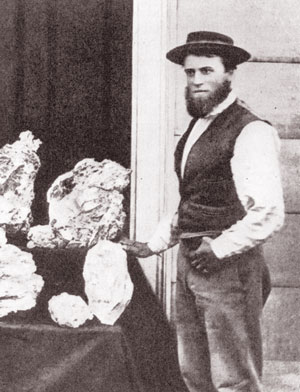
Louis
Beyers with smaller specimens of reef gold
from the syndicate's
mine. (Photograph
by Merlin)
Beyers' tastes were simple. All he asked from life was to live quietly amongst his many Hill End friends.
Not so Holtermann; he was the restless type, with every day presenting the opportunity of engaging in some fresh activity. As one of the town's wealthiest citizens, Holtermann began to interest himself in a host of personal and civic activities.
He purchased ground and built two blocks of smart shops in brick(4); he, secured a controlling interest in the Hill End Observer; he associated himself as a guarantor with the building of the Church of England and Presbyterian Churches; bought himself the latest in the way of American buggy turnouts, complete with a pair of high-stepping dapple greys; became (in company with Beyers) an office-bearer of the Sons of Temperance Lodge and contributed substantially to their efforts in the direction of building a large Temperance Hall(5).
In between times he visited the other areas in New South Wales and Victoria where there were finds of gold. He surveyed Sydney in some detail searching for a fine piece of ground that would be suitable for a great house that would be worthy of the family name. He was forever thinking of ways of adding new lustre to the name of Holtermann, and, going further, gave thought to plans for adding new fame to his adopted land.
Through all this he. did not, of course, lose touch with the source of his wealth. When on the 17th April, 1872, the Beyers and Holtermann claim was floated into a company (under the title of Beyers and Holtermann "Star of Hope" Goldmining Company), the old partners not only received £72,000 for their two shares, but Holtermann retained a large shareholding and also arranged to have himself appointed mine manager(6).
However, it is fairly clear that he did not take the appointment and its responsibilities over-seriously. This is clear from the letterbook of the company which, extraordinarily enough, has survived the passage of time. He asks for leave of absence-is granted it, yet fails to return until months after the due date. On other occasions, he appeared to be absent even without the routine. of requesting permission.
Still, it is fairly clear that on most of these occasions he could not have been very far away, and, certainly, when a particularly rich vein was located early in October he was quickly back on the job giving personal attention to both the mining and the crushing. Some of those mid-winter days were almost certainly spent in the company of Merlin as he photographed the more important N.S.W. country towns.
Merlin's fine coverage of Sydney Harbour in those days of the great sailing ships, at first thought to have been made at this time, has now been more accurately dated to late July or early August, 1873, by the fortunate inclusion of a Harry Rickards' concert poster, the occasion being the company's second opening in Sydney.
And then, suddenly, the great day!
The occasion was the 19th October, 1872, the day on which there was found in the company's mine the largest specimen of reef gold ever known in the world. It was detached as carefully as possible (some broke off in the process) under the supervision of Holtermann and Alfred Bullock, the assistant mine manager, and eventually brought to the surface.
Looking back, it is clear that from the first Holtermann regarded the "nugget" as his very own; it assumed the significance of some great mascot or talisman that would carry him forward to everything the world had to offer. There must be a photograph, of course - one that would permanently record the outward appearance of the great specimen and those associated with its discovery(7).
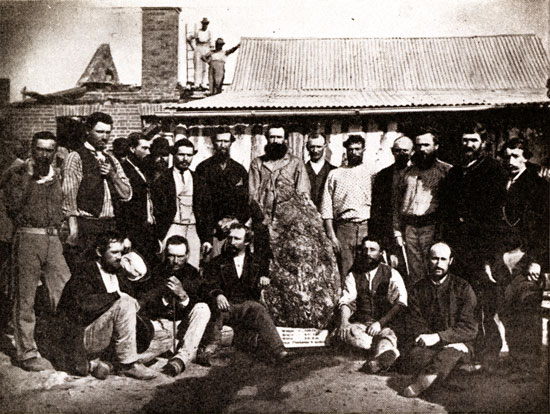
The finding of the "nugget"; to the left is to be seen Holtermann and to the right Alfred Bullock; those in the back row, commencing second from the left, are: L. Burns, J. Smith, D. Hogan, J. Williams, H. Burgess, M. Hogan, J. Hendry, A. Greek, H. Miller, E. Williams, E. Whalen; in the front row: Gunivitch, R. Kerr, Holtermann, Bullock, W. Roberts.
(Photograph by Beavis Bros., Bathurst)
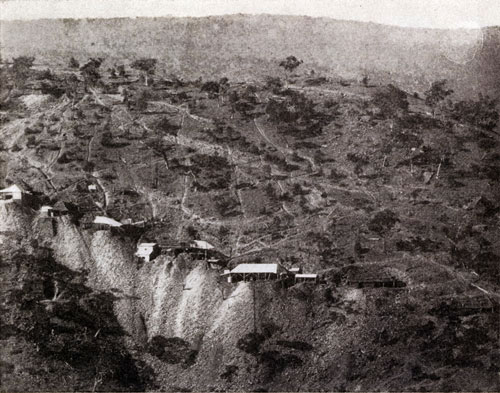
The western side of Hawkins Hill, showing line of reef; the Beyers, and Holtermann claim would be about the centre of the buildings shown. (Photograph by Merlin)
Next he would make a generous offer to the company for its purchase(8), he would suggest £1,000 or more above the estimated market value of the gold content.
Alas for his plans; the Board was far away in Sydney and there had already been some awkward enquiries over missing specimens that someone or other sought to preserve from the devouring jaws of the crusher. In any case, Boards are notoriously lacking in sentiment where hard cash is concerned ... and so it was that the great "nugget" duly went with the other matrix material to Pullen & Rawsthorne's Battery.
All that remains today is its portrait and those few figures on paper which showed the results of the month's crushing-a grand total of 15,581 ounces, this from 72 tons of stone, or a return of 57 ounces to the ton(9).

H. P. Guyer, volunteer firefighter of Hill end. (photographer A&A Studios)
Justifiably enough, on the 13th Nov., Holtermann was missing again, assuaging his disappointment in his plans for the future. They had taken his nugget from him, but they could not take away his dreams . . to his dying day it was to remain "his nugget" - nor could they take away his pleasant memories of the many outings with "his" photographer.
The New Year found him back at the mine, but for him the glamour had gone from the area; following the February crushing he resigned his position.
There were -other happenings, too, the memories of which must have rankled, causing him to feel that he could never feel quite happy about living in Hill End. With the backing of his many friends, he had nominated himself as a candidate for the new Goldfields Division at an 1871 State Election.
This was also a period of great speculation in Hill End mining properties. Following on the finding of rich quality veins on Hawkins Hill, there was an influx of strangers to the district-speculators and company promoters - as had never previously been seen.
Before the year was out no less than fifteen hundred claims had been staked out and shares in these futureless mines were being offered on the Sydney market, backed by exaggerated references to the fabulous riches already won from the field.
Holtermann thought it was high time that the public should be warned against such bogus ventures. To warn the investing public is one thing, but it is quite another to go on to say that "speaking from experience, as one who had prospected the whole area, that there was little likelihood of any payable gold being found at any part of the Hill other than in the several already well-established and reputable mines."
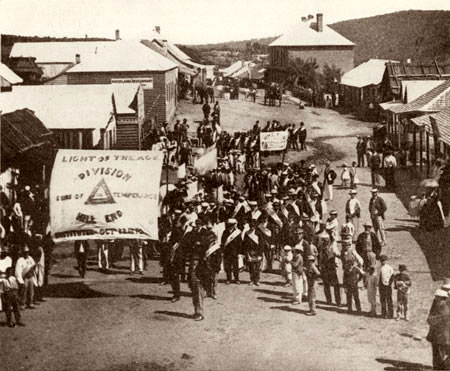
Sons of Temperance procession forming up at the southern end of Clark Street, Hill End, preliminary to the laying of the foundation stone of the Temperance Hall in IL872, probably about the time of the second anniversary of the Division. (Photograph No. 70275, by "A. & A.", taken froirn the balcony of Coyle's Hotel. The two-storeyed building in the distance is the old Australian Joint Stock Bank, which is still standing; Louis Beyers' cottage, situated behind the trees just this side of the Bank, is also standing.)
Copies of The Sydney Morning Herald of 20th Nov. which carried these remarks arrived at Hill End on the eve of polling day and were immediately seized upon by the opposing electoral faction, by the frustrated speculators, and by a large section of the townsfolk.
Tempers rose to a high pitch, and the following morning (26th) an angry crowd burnt his effigy publicly in the streets. Large placards ridiculing him were printed and paraded, while the Hill End and Tambaroora Times of the same date carried an editorial denouncing him as a traitor to the gold-fields.
On his return he had challenged all and sundry to face him and to deny the truth of his remarks, yet none had come forth . . . but in the end he had lost the election by five votes. And so there departed from Hill End the most colourful of all its many colourful citizens.
He did pay subsequent visits to the town. One such visit is noted in his diary for 1874, when for April 25th he writes: "Started for Hill End from Bathurst, river very rough. Hill End looking very dull, everyone complaining. Stayed at Tambaroora." While there he took the opportunity of renewing acquaintance with Beyers and other old friends; and on May Ist he "went with Beyers through all the mine and same looks pretty well."
His overall comment was only too correct. From the "nugget" year of 1872 the annual Gold Escort returns from Tambaroora (which included the Hill End field) fell quickly; 80,592 ounces, then 62,834 ounces, then 25,266 ounces in 1874, the year of which he wrote(10). By 1879 the return was no longer to be counted in five figures. It was the end of an epoch in more respects than one.
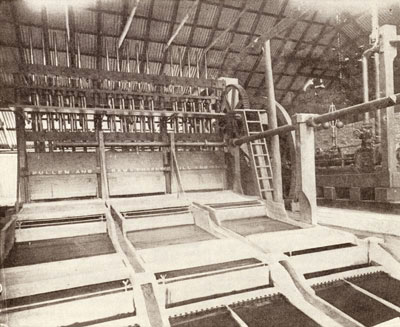
Pullen and Rawsthorne's 'new' cruching battery erected at Hill End in June 1872 - this was the battery through which passed the giant specimen. It was an Australian production of "P.N.R." and was featured by the firm in an advertisement in the Illustrated Sydney News for June 1872. (photographer Merlin, 1872, format 10" X 12")
The year 1873 was running on and his thoughts must mainly have centred around his proposed new home in North Sydney. He had found several acres of ground, facing Union Street, exactly to his taste-the area was across the harbour on the 'Shore' in that locality's most commanding position.
There was also a house in nearby Susannah Street which could be occupied while the new building operations were in progress. The building must be one that would be worthy of a man whose fortune ran to five figures - and it must have a tower, an eminence from which he and his friends could feast their eyes on the glories of the harbour.
And why stop with "eyes", why not some great photographs that would imperishably record the glorious prospect?
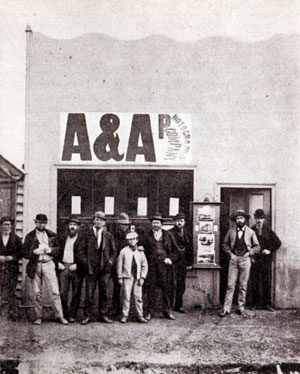
Studios of A&A Photographic Co Tambaroora St Hill end, showing members of the staff (three figure on right) and passers-by. The display shows photographs of Sydney Harbour and one of the newlt completed (1870) western wing of the Sydney GPO. (photograph by Merlin, No 18821)
Photography - that word of happy associations (for almost a year, on and off, Merlin had been working on the great project). He had equipped his photographer with a large new caravan(11) that would conveniently handle the 10' x 12" plates - the size which had been decided upon as the standard for the project. Already a magnificent series of exposures had been completed and stored away in specially made and fitted cedar boxes. Sydney, Hill End and Hargreaves had been covered, and so had Bathurst, Orange, Dubbo, Carcoar, Goulburn, and several other areas.
He began to wonder whether he might not go further than photographs and introduce a note of reality by including mineralogical specimens and models of mining machinery, as well as stuffed birds and marsupials? That would be a worthwhile project and one on which he would be willing to spend as much as £15,000. As to the photographs - would mere albums be striking enough? - there was the new Graphoscope device for magnifying photographs and making them appear more brilliant.
And then, one morning in mid-winter, Merlin came to him bearing serious news; he said that, owing to failing health, he could no longer carry on with the photography. Yet the great project need not be abandoned; he believed that the enterprise could well be carried on by his Melbourne assistant, Charles Bayliss(12).Though but a young man of twenty-three, he had been associated with Merlin for almost seven years. He could recommend his services with the greatest confidence. Not that there could really have been much debate about the appointment by either party; competent landscape photographers were not exactly plentiful in 1873, and, in any case, the devoted Bayliss must have felt a strong moral obligation to carry on with the work that his chief had been forced to abandon.
It would appear that it was sometime towards the end of 1873 that Bayliss took over the enterprise. Probably he first carried on with the 10" x 12" series, using the Victorian provincial towns as subject matter. The five hundred odd negatives of this format have not as yet all been identified, or even all printed, so it is still not possible to state with any degree of accuracy when and where one photographer left off and the other commenced; it is hoped that the point will eventually be determined by internal evidence. One point, however, is fairly clear; whereas the 10" x 12" format must have seemed fairly large to the stricken Merlin (who had grown up in the carte-de-visite period), it certainly did not appear so to the younger, more energetic man. He began to talk in terms of 18" x 22"(13) , and his patron was quick to see the point; then, as today, it is not only the subject matter but the impact that counts in a photograph.
Bayliss' first coverage in the large format was most probably a personal picture for his patron. In the middle of April, Holtermann noted in his diary: "Settled with Jacobs about Post Office Hotel(14) for £4,090," and, of course, there had to be a photograph recording the purchase - and Bayliss made sure it was a good one by making two exposures, both of which turned out first-rate. The first major undertaking with the new equipment appears to have been the coverage of Ballarat - some twenty or thirty exposures of mines, buildings, streets, and, of course, the great nine-exposure 3600 panorama. The latter can be accurately dated to March, 1874, through the fortunate circumstance of the field of view which includes the campaign posters of two rival election candidates - one Jones and one Sargeant, who fought it out on the hustings of that period.
About this same time there must have been many talks between the pair about the proposed photography from the tower. In the end several important decisions were reached: firstly, that the proposed panoramas should be dramatically large, several times bigger than any known photographs; secondly, that they should not only be giant panoramas - they should also be telephotographs (item, a lens of about 100" focus - the largest which could be operated in the limited space available - to be ordered to be specially made in Germany). Finally, the pictures were to be completed in time for the world's greatest Exhibition the Philadelphia Centennial, which was due to open in two years' time.
For the year 1874 we have, at our side as we write, Holtermann's private diary. Unfortunately there are entries only for about half the days of the year, but those entries are both illuminating as to his manifold activities and pungent as regards his comments on his fellowmen. It is hardly a document to be considered piecemeal, and our readers will, therefore, forgive us if we reserve the story of his multigarious doings for a future occasion. Sad to say, there is only one reference to photographic matters. This is on January 2nd, where the entry reads: "Hunt and Bayliss getting things ready. Cases for Exposition." He does not state what "Exposition," but it would be either Brussels Exposition of Industrial Art or the 1874 Exhibition in Prince Alfred Park (Sydney).
The outstanding event of the year was the completion of the tower. We read with interest the entry for August 29th: "Put on the top of the tower the last stone boring [turning] ... Slept in new house for protection to same without blankets," and that for September 11th: ". . . Building tower roof to little gutter-not deep enough," and finally on November 9th (Lord Mayor's Day-at that time a holiday): "Regatta watched from top of house for some [time]."
There was another little assignment for Bayliss about this period. Space had been provided in the tower for a circular window which would provide the finishing touch to the fine structure-nothing less than a handsome window in stained - glass that would show to every visitor the likeness of the master of the house and of the great nugget which he had found. He would get his photographer to make up a composite picture of the desired arrangement, which would serve as a guide(15) for the stained-glass artist.
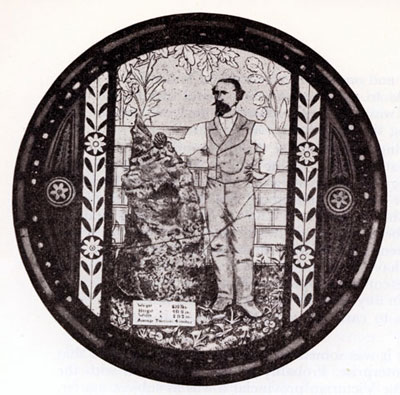
A photograph of the stained-glass window originally in Holtermann's Tower and now in the archives of the S.C.E.G.S. See also cover illustration and reference in text. (Photograph by J. C. Young)
The following year, 1875, was destined to be the memorable one in the annals of photography, for it was in that self-same year that there were successfully coated, exposed and processed, "in far-off Australia," the largest photographs ever made in the world by the wet-plate process.
The work appears to have been commenced in the winter, so that advantage could be taken of the good visibility ever associated with Sydney's westerlies. The first task was to board-in the tower in order to make a light-tight room - veritably a ten-foot-cube camera atop an eighty-foot tripod. The world's largest camera for the world's largest photographs!(16)
Opportunity was also taken to make a continuous 360° panorama 33 feet long with the 18" x 22" camera - this proved to be equally successful. "It included the whole of the city of Sydney and suburbs, the harbour and surroundings up to a distance of four miles and more accurately than can be seen with the naked eye . . . signboards three miles away on the sides of houses can be read with ease on the prints where it is quite impossible to see even the house when one is standing on the top of the tower."
About the time the negatives were completed there was a sad interruption. At the end of August, the body of Commander Goodenough was brought back to Sydney on its last journey; he had died at sea from wounds received at the hands of the natives on the island of Santa Cruz.
Somewhat disrespectfully, the coffin appears to have been brought across the harbour to Milson's Point by steam horse ferry. The occasion was deemed by Holtermann worthy of photographic record - as, indeed, it was - and the resultant 18" x 22" negative has come down to us in perfect condition, and, incidentally, is perhaps Australia's earliest "news feature" photograph of any importance.
The year, too, ended on a note that must have saddened Holtermannit was the closing down of the "Star of Hope" on December 28th.
The New Year saw Bayliss back in Melbourne. His principal task was to secure a panorama of the city in 18" x 22" format. For a vantage point he selected the tower of Government House. His negatives have survived - they are good technically but not very interesting in subject matter, as the principal objects of interest are too far away. He also photographed Scots Church and The Bank of Victoria; the date of the latter exposure can be accurately dated by a graffito, for some New Year celebrant has chalked '1876' on the stonework.
As for Holtermann himself, the first half of 1876 must have represented an exceedingly busy period, as he planned for his forthcoming trip abroad and arranged for the control of his numerous enterprises during his absence. And, of course, he must have supervised the packing of the great cases that were to carry the results of his photographic enterprise to the huge Centennial Exhibition and that were to arrive in Philadelphia in good time for the opening day of May 10th. In addition to the photographic exhibit, which went on ahead, he also arranged for a quantity of duplicate material to be prepared in order that he might take it with him and display it as he went along.
He sailed with his wife and daughter early in June, arriving in San Francisco some time in July. An item of interest wa's later to be seen in the Evening News (Sydney) for Sept. Ist:
"The Photographic Society of the Pacific Coast held a regular monthly meeting last evening in the galleries of Messrs. Bradley & Ralston, Montgomery Street, San Francisco. Mr. Ralston proposed the name of Mr. B. 0. Holtermann, of Australia, for membership. Mr. Ralston offered the following resolution:
"That as photographers we are indebted to the liberality of B. 0. Holtermann for demonstrating the possibility and perfecting the production of the largest negative, and we tender him our thanks of this Society for kindly placing the negatives on view for inspection.
"Mr. B. 0. Holtermann, responding to the resolution on his behalf, begged the Society to accept his sincere thanks for the reception he had received in San Francisco by the fellow members of his profession."
From San Francisco the family (and presumably the big negatives as well) hastened by rail eastwards across the continent. But a pause was necessary when the family reached Burlington, on the right bank of the Mississippi River, about two hundred miles from Chicago. The important reason for the pause was fully explained, in journalistic writing very characteristic of the time and place, in the columns of The Burlington Hawk Eye of July 25th, 1876 - to say nothing of the obvious rivalry between the Iowa cities of Burlington, Devonport and Dubuque:
"There was a native Australian born in Burlington yesterday, and whether he is an American of German descent or an Australian of American extraction, or a citizen of Germany with Australian ancestors will be a question of some joint High Commissioner to settle the first time he is drafted.... This man came very near being born at 25 m.p.h., and if the C.B. & Q. Line wasn't so reliable, or had even missed being on time, he could never have sworn to his birthplace in the world. As it is, however, thanks to the never-failing promptitude of the C.B. & Q., this young German-American-Australian can lay his hand upon his heart and with a look of honest pride say, 'I am a native of Burlington',
"B. 0. Holtermann, a resident of Sydney, Australia, and member of an extensive firm, Holtermann & Co., of that place, is on his way with his wife and daughter and a servant to Hamburg, Germany. Careful of the comfort of his lamily, he chose the shortest and safest route across the continent, which is well known to the C.B. & Q., and Holtermann, after changing his through checks for his baggage for Depot checks, sought and obtained commodious and comfortable quarters at the Barret House where, in Room No. 39, within two hours, a son was born unto him whom' he would do well to christen Burlington.(17)
"It is, indeed, a high mark of appreciation of our fine institutions when the denizens of other quarters of the globe bring their children here to be born.
"Talk about your cities. Did anybody ever go to Devonport from Australia to be born? Did anybody ever stop at Dubuque on his way to Germany to be born? Not much; and we trust that this simple little illustration of the superior attractions of the Orchard City will not be lost upon our less fortunate ne'ighbours, but that they will gracefully, and with that modesty that so well becomes them, sink into the obscurity that must henceforth gather around them from the shadow of this crowning triumph.
" . . . . He refused to be interviewed, but is said to be very handsome and the living image of his father and mother. He will remain at Burlington for a short time and will in all probability proceed with the family into which he has introduced himself when they leave the city.
"We shall watch his career with interest and shall expect to find in his history further evidences of the superior advantages which the metropolis of Iowa affords to those who seek its friendly influences .
Of his stay in Philadelphia, no record has come our way other than the record of the Exhibition which shows that his photographic exhibit gained a bronze medal (no silver medals were awarded at Philadelphia Centennial, says the Encyc. Britt., ninth edition). Nearly ten million people saw the huge 159-day Exhibition; the maximum attendance for any one day was 274,919 (about fifteen thousand more than of Sydney's Easter "Royal"). Presumably, most of them saw the big panorama and the hundreds of other supporting photographs, and so came away knowing considerably more about Australia than they had previously. That Holtermann would naturally have spent some time in Philadelphia, explaining his exhibit and lecturing on Australia and its great future, is fairly certain.
In due course, the Holtermanns moved on to Germany where he again demonstrated his collection, met his relatives and looked around for agencies suitable for the Australian market. The party returned to Sydney some time in 1877, but the famous pictures remained behind in order to be shown at Paris' famed Exposition Universelle Internationale de 1878, where they were successful in gaining a silver medal (now to be seen in The Mitchell Library). The Exposition was by far the, largest of its day, attracting thirteen million visitors. No record is given of the maximum single-day attendance.
At Paris, incidentally, there was another interesting association with photography. To quote from the Encyc. Britt. (tenth edition) : "Every person who had the right of entrance was compelled to forward two copies of his or her photograph, one of which was attached to the card of entry."
It is impossible for us, almost a century later, to recapture the glamour and the public appeal of these great Exhibitions, for almost from infancy we are familiar with the world's great inventions and national characteristics - and that mainly through the instructional value of photography.
As for his personal portable exhibit, this took the form of "a sheet of canvas 80ft. long and 5ft. wide, full of panoramic views of New South Wales" (but no doubt a range of Victorian scenes was included as well). As Holtermann displayed his roll throughout Germany, France and Switzerland, his natural pride would have been pardonable; further than that, it is certain that he represented Australia's first overseas Office of Information, official or unofficial.
Back in Sydney, Holtermann established himself as a merchant and commission agent at 24-42 Pitt Street (afterwards at 674 George Street and 248 Liverpool Street). His interests were varied, ranging from sewing machines to lager beer (another gold-mine, said the newspapers!), and from telegraphic equipment to gas-producer plants for home gas lighting. He also carried on with his mining associations, mainly at Molonglo, though he held many other leases, some even as far away as Darwin.
The following year was the completion of the buildings for Sydney's famed Garden Palace Intercolontal Exhibition(18)-an activity which appears to have tempted Charles Bayliss to move. permanently to Sydney. The Exhibition was held in the two years 1879 and 1880, the Holtermann pictures being given due honour. It is pleasant to note that an entire bay was devoted to his photography and that the full credit was given to the photographers responsible.
His grand international project carried through to completion,(19) Holtermann began to lose interest in photography, but not before he had completed (in 1881, from internal evidence) a panorama on 10" x 12." plates actually made with his own hands. He also purchased a stereoscopic camera (an 1879 model by Attewill & Co., London, with a pair of Ross lenses), with which he made an intensive series of exposures, mainly of family, friends and scenes around his farm in West Street.
It is clear that by this time he had lost interest in his tower and was thinking more of a new home - St. Leonards Lodge, in the area just to the west of the present St. Leonards Park(20) and of local public activities. By 1883 he had been elected M.L.A. for St. Leonards and was energetically renewing his work towards the progress of "North Shore". He is said to have been instrumental in the building of the North Sydney Post Office and Court House (which were completed in 1886) and in the laying of the tramway from Milson's Point. He advocated the bringing down of the railway from Hornsby to St. Leonards and even offered £5,000 towards the cost of building a bridge across the harbour.
To the end he retained his belief in the importance of photography as a means of - stimulating the world's interest in Australia, particularly from the aspect of "exciting the attention of the most desirable class of immigrants and others to the advantages offered for the introduction of skilled labour into this country" as he moved in the Assembly on April 10th of "46, Victoria"; on this occasion he endeavoured, unsuccessfully, to obtain for the purpose a grant "not exceeding £2,000."
Bernhard Otto Holtermann died on 29th April, 1885, being then but forty-seven years of age. Neither in the newspapers of the day nor anywhere else until this year was full and proper tribute ever paid to him, either for his national work or for his countless acts of friendship and personal generosity. Though he did not live out the normal span of life, it can be said that he died a happy man, for had he not achieved the three great ambitions of his life. He had gone out alone into the unknown and found some of Australia's "legendary", gold in that place with the magic-sounding name. He had in some small measure repaid his adopted land for the many favours it had conferred upon him. And lastly, he had attained the greatest wish of his life, to sit as a member of a British parliamentary body.
Gold and silver ... the gold of Holtermann, the silver of Merlin and Bayliss ... a 'natural electrum' that was to prove infinitely more precious than anything that the ancients could ever have imagined.
- His interest in the healing art was destined to remain a matter of deep concern with him all his life. (See appendix: "1874-The Diary Year," to be published later.)
- "Some 14 lbs. of blasting powder exploded in his face, two feet away, when he was hanging on a rope 20 feet from the bottom of the shaft and 110 feet from the top." (Town and Country journal, Apt. 22nd, 1876.)
- It would appear that credit for finding the vein in the Beyers-Holtermann claim must go to Mark John Hammond, later M.L.A. for Canterbury, N.S.W. The matter will be referred to again in an appendix.
- The shops were situated at the corner of Short and Tambaroora Streets and along the latter up towards the present Presbyterian Church. Between the last brick shop and the church stood the wooden buildings which housed the Hill End Observer and the A. & A. Photographic Company.
- The occasion of the laying of the foundation stone (perhaps in October, 1872) was the subject of a number of "news" photographs (by "A.& A."), one of which is reproduced. Local recollection suggests that the hall was never actually completed.
- The old records throw interesting sidelights on current economic standards. The sub-managers at the mine drew wages of 60/- per week while the first local accountant (Salier) received 30/-, and his successor (James Barrie), 20/-. Candles, a major item, cost 11d. per pound and blasting powder (which was ordered by the half-ton), 13d. or 14d. per pound. Later on, after the rich crushings of November., 1872, Holtermann was emboldened to recommend an increase in the wages of the two sub-managers from 60/- to 70/- per week; this was duly agreed to by the Board. Holtermann forthwith took the liberty of marking the payroll as 80/-. Fortunately, the Board was in a good mood and confirmed his action; it also agreed to his further recommendation of "a holiday on full pay for all hands on Christmas Day." But not," said the Board, "for any of the other holidays."
- "After two day's work, the mass still being a fixture, crowbars were brought into requisition; and the result, attendant on the labour of three men for some hours, was that the specimen ... by the united exertions of twenty men and a horse, was brought to the surface and conveyed to Hill End, where it was exhibited for a small fee for the benefit of the District Hospital." (Town and Country journal, 22nd Apl., 1876.)
- Several contemporary accounts refer to the fact that a "showman" wished to purchase the big specimen. It is fairly clear that there was only one "showman" likely to be interested in purchasing a specimen worth £12,000 and that would be Holtermann himself.
- Payable gold today is reckoned in pennyweights rather than in ounces. A small syndicate would perhaps show a profit on five or six "weights" to the ton.
- These would represent mainly quartz figures. In the rich alluvial period the returns averaged about 20,000 ozs. per annum.
- The new caravan appears in several of the pictures. It was inscribed "B. 0. Holtermann, Photographer. Photographs purchased." However, there is no evidence that any photographs were ever purchased, with the exception of the "A. & A." coverage of Gulgong and Hill End, which action would, no doubt, be dictated partly by, sentimental reasons and partly as an act of generosity to Mrs. Merlin in her widowhood.
- The life of Charles Bayliss is to be the subject of a special chapter - Chapter Three.
- While enlargement was possible on albumen paper, it was the exception rather than the rule. The paper was very slow and the only possible light-source was sunlight directed by an arrangement of mirrors. An alternative was the indirect method of making a positive and then an enlarged negative by projection; for this procedure artificial light could be used for illumination. The various enlarging processes of the day were the subject of a lengthy article in the British Journal Almanac for 1878.
- Two sections of one of these photographs are reproduced in the portfolio.
- In this issue there are reproduced both Bayliss' montage and the actual window as now preserved in the S.C.E.G.S. archives - see footnote is below.
- It is considered that the "world's largest wet-plate photographs" are worthy of a special article and it is therefore proposed to devote an appendix to them and their production.
- Holtermann did not accept the newspaper suggestion, giving to his eldest son his own Christian names; nevertheless "Burt" remained as a nickname to the mates with whom he played football as a lad. He did not live to see his twenty-first birthday, dying on June 27th, 1897.
- With the exception of a showing at Calcutta in 1884, this was the last public appearance of the famous collection. Nothing has been ascertained as to the fate of these original prints
- The house was rented in turn by R. Saddington and Edward Chisholm. On Holtermann's death, the tower and its grounds (stated to amount to about eight acres) were purchased by Sir Thomas Dibbs. The latter sold the building and some of the land to the trustees of the Sydney Church of England Grammar School in 1888. While there has been a considerable amount of rebuilding, the tower and at least one of the rooms remain as a permanent monument. The tower was renovated in 1934, when the old-fashioned ornamentation was removed and the whole refaced with modern brickwork, while the circular windows were altered to conform with the general architectural scheme. A brass plate set into the base of the tower describes it as "Holtermann's Tower" and gives its present height as 73ft. 5in., also its latitude and longitude, for it is now a permanent "trig." station. Owing to new buildings and much tree growth it is not quite the landmark that it would have been in 1874. Surprisingly, no photographs have been found in the collection showing the tower looking back from Milson's Point.
- The area was long ago subdivided, but there remain memories of Holtermann's residency in the names of nearby streets, viz., Holtermann Street, Merlin Street, Emmett Street (named after his wife, whose maiden name was Emmett), and Myrtle Street
A selection from the photography 1872 - 1876
images
below are as cropped
in the original journal
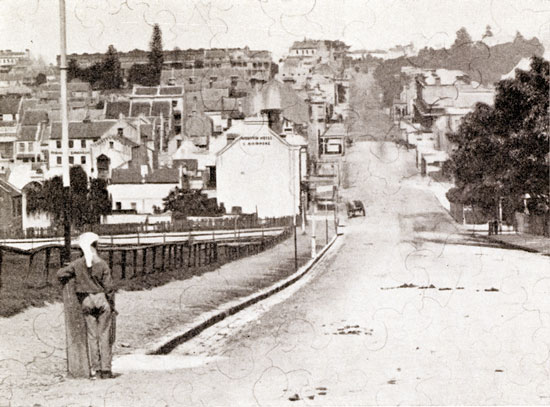
William
Street, Sydney, looking east from a point just
below the Australian Museum. In the foreground
can be seen an assistant holding a spare dark slide.
The terrace along the left skyline still stands-this
is Alberto Terrace, in Darlinghurst Road, at that
time regarded as Sydney's "largest and finest." Mitchell,
of Mitchell Library fame, lived just beyond its northernmost
end. (Year, 1873; photographer, Merlin; format, 10" x
12')
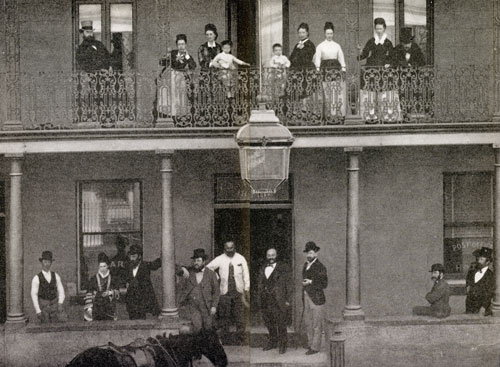
A group outside the Post Office Hotel (111 York Street, Sydney), showing Holtermann on the extreme right, street level. The latter's diary mentions the fact that he finalised the purchase of the hotel on April 16th, 1874.
Bradshaw's "General Guide and A.B.C. Gazeteer of September, 1866" contains an engraving depicting the hotel with John Jacobs' name appearing as proprietor. It describes "this, favourite hotel as well adapted for gentlemen, families and storekeepers. Being near the Post Office, principal Banks and Warehouses, and, as it has just been redecorated and newly furnished with another storey added, there is very superior accommodation, handsome drawing-rooms, and large and well ventilated bedrooms, bathrooms and every convenience that a first-class hotel requires."
N.B.-York St. appears to have been re-numbered at a subsequent date; the previous No. 111 would have been between King and Barrack Sts. (Year, 1874; photographer, Bayliss; format, 18' x 22')
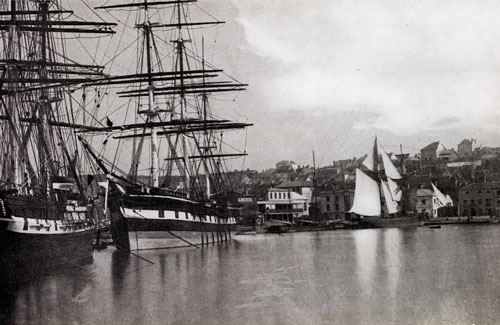
Circular
Quay, Sydney, in the winter of 1873, showing
the sailing vessels "Surrey" and "La
Hogue." ( ?) This is one of a very extensive
Harbour series attractively photographed during
this period. (Year, 1873; photographer, Merlin;
format, 10' x 12")
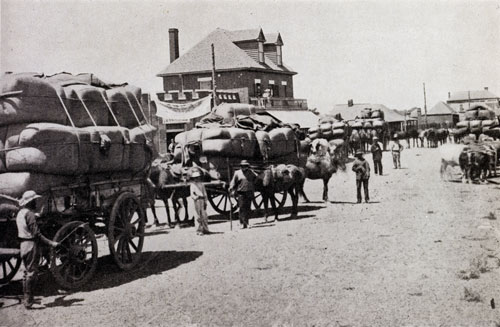
Wool-teams
arriving at Dubbo from sheep stations in Brewarrina
and other districts to the north-west. The
scene is in Macquarie St., the buildings being
respectively Serisier's Stores and the Overland
Hotel. (Year, 1872/3; photographer, Merlin;
format, 10" x
12")
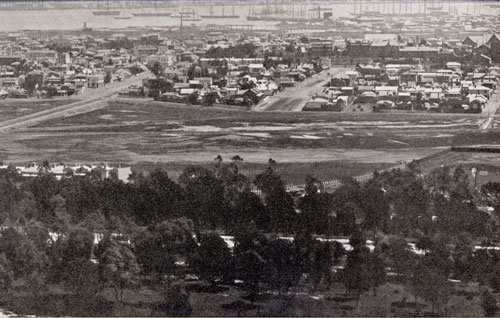
Looking
west to Albert Park and Port Melbourne, one
of a number of exposures making up an extensive
panorama from the tower of Government House,
Botanical Gardens,
Melbourne. (Year, summer 1875/76; photographer,
Bayliss; format, 18" x 22")
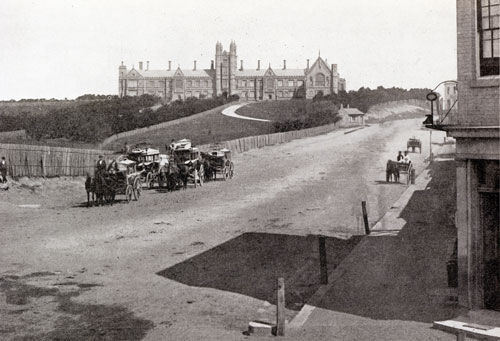
The University of Sydney main building (completed 1859), looking west along Parramatta Rd. from the corner of Bay St., now occupied by Grace Bros. The omnibuses were those of the Sydney Tramway and Omnibus Company, which had a depot nearby. (Note: There is no evidence that the company ever conducted a tramway.) (Year, 1873; photographer, Merlin; format, 10" x 12)"
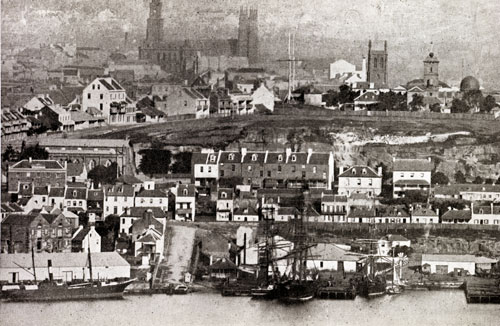
Observatory Hill from Holtermann's Tower-sections of one exposure of the 360° panorama made with the 100" lens on the 18" x 22" camera. Features include St. Phillip's on Church Hill, the Town Hall and St. Andrew's Cathedral, and, faintly in the distance, the Exhibition Building in Prince Alfred Park. There is a considerable degree of foreshortening due to the use of so powerful a telephoto lens. (Year, 1875; photographer, Bayliss; format, 18" x 22")
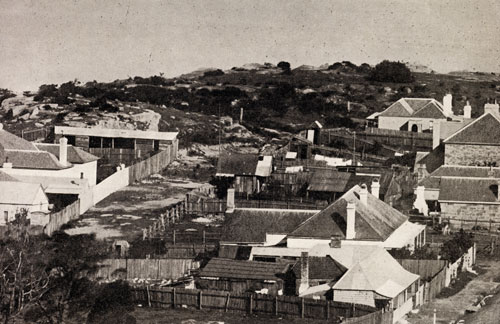
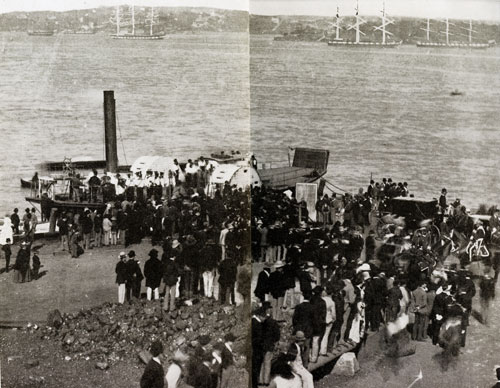
Commodore Goodenough's funeral cortege assembling at Milson's Point on the afternoon of August 24th, 1875. We are indebted to H. J. Rumsek for identifying the picture and supplying this historical data: " The following notice, together with a portrait and accounts of the massacre and funeral, appeared in the 'Sydney Mail' of August 28, 1875: 'A Gazette extraordinary was issued as follows:
Colonial Secretary's Office. His Excellency the Governor, with feelings of deep regret for the public loss sustained, announces to the ,Colony the death on Friday, August 20, from wounds received at Santa Cruz (Carlisle Bay) on the 12th of the same month, of James G. Goodenough, C.B., C.M.G., Captain and Commodore Commanding Australian Station.
The funeral procession will move from Milson's Point, North Shore, at 3 o'clock p.m. to-morrow, 24th August, and his Excellency,. With a desire to show -every possible respect to the memory of the deceased, directs that the Public Offices be closed and -invites the attendance of all Officers of the Government.
By His Excellency's Command, John Robertson, Colonial Secretary.'
" The 'Sydney Morning Herald’ of Aug. 24/25 also has reports and, in addition, a poem of thirty lines, 'in Memoriam,' of which the two first are:
'Slowly the long procession moves with solemn sound
Ere one of England's noblest men be laid in New World ground . .
Note - Close inspection indicates that the coffin is still on board the paddle-steamer and that the naval ratings are preparing,, to draw it to land. The paddle-steamer would probably have been the "Transit," the vagaries of which were the subject of much contemporary comment. (Year, 1875; photographer, Bayliss; format, 18' x 22')
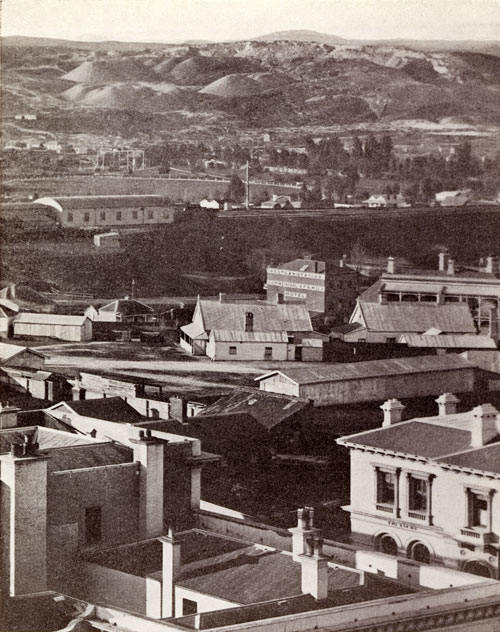
Ballarat, showing portion of the city and the goldmines - one exposure in a nine-exposure 360° panorama photographed from the tower of the Town Hall. (Year, 1874; photographer, Bayliss; format, 18' x 18')
return to APR main page